|
EARLY
SUMMER JUNE 2009 UPDATE
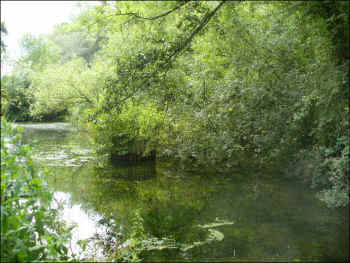
I
am always amused by the tornado like the one seen in The Moor
car-park today; ‘wind devils’ I think we call them over here.
In the right conditions of heat and light wind, these
mini-twisters can crop up anywhere but they always seem to look
out of place in UK. However, it served to remind me what changes
have occurred since the last update.
Since
then, untold millions of birds have moved north to breeding areas
across the globe. We have at last received the latest-arriving of
these; the Hobbies and the Spotted Flycatchers, though
apart from Hobbies watched regularly by John-Lloyd Parry near
Widbrook, not everyone might be lucky enough to spot them. One
might hope it far easier to spot other spring harbingers such as Swallows
and House Martins, but just how many are there around the
Cookhams currently? I’ve seen very few of the former and only
one nesting pair of the latter. If you know different, please do
let us know.
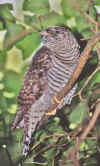 A
few Cuckoos have been heard, including one Pam Knight heard
near the Pound, and one was calling regularly near Strand Lane for
a while. I was fortunate to hear the bubbling call of a female
just yesterday, usually a precursor to egg-depositing. Might that
result in what John Lloyd-Parry managed to photograph a few years back? A
few Cuckoos have been heard, including one Pam Knight heard
near the Pound, and one was calling regularly near Strand Lane for
a while. I was fortunate to hear the bubbling call of a female
just yesterday, usually a precursor to egg-depositing. Might that
result in what John Lloyd-Parry managed to photograph a few years back?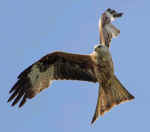
The merge from spring to early summer has been
marked by better weather than the last two years and resulted in
good success for nesting birds, with lots of baby tits, Blackbirds,
Dunnocks and Song Thrushes being reported. Cygnets
were produced by the Strand Water Mute Swans, alongside two
or three families of Coots. JLP
also managed to photograph a family of Kingfishers which
bred near White Place Farm. Our only
Rookery, near Odney Club, had 11 nests and produced about 30 young
ones. This colony was then joined by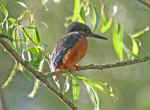 literally hundreds of other Rooks, Jackdaws and Crows
on or surrounding farmland, the highest count I had being 640;
quite a spectacle. Kites too have remained faithful to the
village with typically 40 around, as seen by Pauline Evans on June
8th, and including one which got just a bit too close to Martin
Glover’s lens.
literally hundreds of other Rooks, Jackdaws and Crows
on or surrounding farmland, the highest count I had being 640;
quite a spectacle. Kites too have remained faithful to the
village with typically 40 around, as seen by Pauline Evans on June
8th, and including one which got just a bit too close to Martin
Glover’s lens.
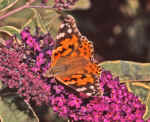 Across
the nation, the balmy weather contributed to a major lepidopteral
event in the form of millions of Painted Ladies swarming
across the Channel and North Sea to arrive on our coasts in huge
numbers. Folk were reporting over 100 per minute passing overhead
and within days, terrific numbers were also being reported at
inland locations. Certainly in our vicinity, it was possible to
see a dozen at a time. They have thinned out now but may well
breed to give us another generation to look for later in the year.
Again, JLP was quick with his camera with one of the hordes.
Local expert David Fuller has kindly offered to conduct
some butterfly surveys in the village for us this year so it will
be interesting to see what he turns up. Across
the nation, the balmy weather contributed to a major lepidopteral
event in the form of millions of Painted Ladies swarming
across the Channel and North Sea to arrive on our coasts in huge
numbers. Folk were reporting over 100 per minute passing overhead
and within days, terrific numbers were also being reported at
inland locations. Certainly in our vicinity, it was possible to
see a dozen at a time. They have thinned out now but may well
breed to give us another generation to look for later in the year.
Again, JLP was quick with his camera with one of the hordes.
Local expert David Fuller has kindly offered to conduct
some butterfly surveys in the village for us this year so it will
be interesting to see what he turns up.
On
the moth front, there have also been some could local records. A Humming
Bird Hawkmoth 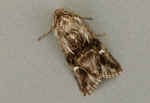 wandered
around the Dean in late May, and the first two Toadflax
Brocades for Berkshire were found locally in the same month;
one in my garden, and one adjacent to Beechingrove Wood. These
might not rate amongst the most visually stimulating: it’s the
mothing equivalent of the ‘rare little brown job’ of the
birding world, but none the less notable for all that. The warmer
evenings have been contributing to
larger ‘catches’ in suitable traps, with
typically 90+ even in small gardens, with stunning creatures such
as Swallowtail, and Elephant Hawkmoths amongst them.
There is a major national programme of recording some of our most
prominent moth species which we would encourage everyone to get
involved in. Called the Garden Moth Count, it operated in a
similar manner to the Big Garden Bird Watch which many of us get
involved in. A quick flick onto www.mothcount.brc.ac.uk
will give you all the information you need and the top 20
species to be looked out for are all readily identified from the
photographs downloadable from the site so it is ideal for all the
family to join in with. Please do give it a try. wandered
around the Dean in late May, and the first two Toadflax
Brocades for Berkshire were found locally in the same month;
one in my garden, and one adjacent to Beechingrove Wood. These
might not rate amongst the most visually stimulating: it’s the
mothing equivalent of the ‘rare little brown job’ of the
birding world, but none the less notable for all that. The warmer
evenings have been contributing to
larger ‘catches’ in suitable traps, with
typically 90+ even in small gardens, with stunning creatures such
as Swallowtail, and Elephant Hawkmoths amongst them.
There is a major national programme of recording some of our most
prominent moth species which we would encourage everyone to get
involved in. Called the Garden Moth Count, it operated in a
similar manner to the Big Garden Bird Watch which many of us get
involved in. A quick flick onto www.mothcount.brc.ac.uk
will give you all the information you need and the top 20
species to be looked out for are all readily identified from the
photographs downloadable from the site so it is ideal for all the
family to join in with. Please do give it a try.
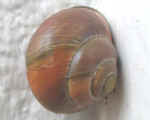 I
hope folk are also getting involved in the snail programme we
highlighted on the Cookham Wildlife Web page. The first generation
of these slimy but beautiful creatures were out and about early in
the spring, and are still plentiful. The eggs they will have laid
take about 6 weeks to hatch, so loads of ‘snail-lings’ should
be abroad soon. I have been finding one, two, three, and
four-banded versions of both the white-lipped and brown-lipped
snails, so I am sure there are plenty in your gardens, school
areas and grassy locations throughout the village. Do get the
kiddies hunting them out! Even some of the plainer varieties such
as Arianta arbustorum
(or Copse Snail) Liz Kwantes managed to photograph in her porch,
can be recorded to give us a good idea of what is around us. I
hope folk are also getting involved in the snail programme we
highlighted on the Cookham Wildlife Web page. The first generation
of these slimy but beautiful creatures were out and about early in
the spring, and are still plentiful. The eggs they will have laid
take about 6 weeks to hatch, so loads of ‘snail-lings’ should
be abroad soon. I have been finding one, two, three, and
four-banded versions of both the white-lipped and brown-lipped
snails, so I am sure there are plenty in your gardens, school
areas and grassy locations throughout the village. Do get the
kiddies hunting them out! Even some of the plainer varieties such
as Arianta arbustorum
(or Copse Snail) Liz Kwantes managed to photograph in her porch,
can be recorded to give us a good idea of what is around us.
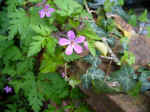 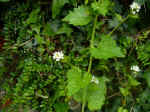 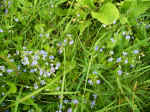
Many
wild plants have been showing themselves off in recent weeks,
around the less-manicured parts of the Cookhams. Popular hedgerow
plants such as Herb Robert, Jack-by-the-Hedge
(Garlic Mustard) and the delightful speedwells have been at their
best, and in some cases already gone over. But well-known
botanist, Keith Lucas led a plant foray on Cockmarsh recently and
led his followers to a whole range of interesting grasses, sedges
and flowering plants. I am just awaiting a list of what was found
and will share this in the next update. I am also delighted that
botanist Alice Fenton is returning to the Cookhams to survey a few
corners of our village to see what she can find to add to a known
list already in excess of 500 species.
Incidentally,
the Natural History Museum has a fascinating facility on its web
site where you can find all the plant species known to grow in
your post code area from surveys over the last 20 years. Simply go
to www.nhm.ac.uk/nature-online/life/plants-fungi/postcode-plants/index.html
and type in ‘SL6’ and a full list appears, many with
associated details and photographs; do have a look.
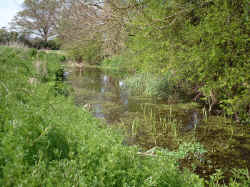 Strand
Water has been alive with damselflies this summer, and I
was surprised to find that the numerous small blue ones I could
see were not Common Blues as I had assumed, but the very similar Azure
Damselfly. If you look at the two species’ photographs on
our village wildlife page (via the Dragonflies box) , you will see
the only way to tell them apart is to see the shape of the little
black mark at the head end of the long tail section. On the Common
Blue it looks like an Oak tree; on the Azure a wine glass
shape. There were several hundred pairs laying eggs onto surface
vegetation on the slow-moving waters of this wider stretch of the
stream. These conditions are ideal for all the damselflies and
dragonflies that breed here; I do hope the phase 2 plans for the
Maidenhead Waterway, which apparently involve ‘improving
flows’ from the Thames via Marsh Meadow and Strand Water will
not put this in jeopardy – it will be a serious loss. Strand
Water has been alive with damselflies this summer, and I
was surprised to find that the numerous small blue ones I could
see were not Common Blues as I had assumed, but the very similar Azure
Damselfly. If you look at the two species’ photographs on
our village wildlife page (via the Dragonflies box) , you will see
the only way to tell them apart is to see the shape of the little
black mark at the head end of the long tail section. On the Common
Blue it looks like an Oak tree; on the Azure a wine glass
shape. There were several hundred pairs laying eggs onto surface
vegetation on the slow-moving waters of this wider stretch of the
stream. These conditions are ideal for all the damselflies and
dragonflies that breed here; I do hope the phase 2 plans for the
Maidenhead Waterway, which apparently involve ‘improving
flows’ from the Thames via Marsh Meadow and Strand Water will
not put this in jeopardy – it will be a serious loss.
Many
thanks again to all who submitted information this session; please
feel free to send in observations, or simply questions to us, and
we will be pleased to help where we can.
B
D Clews
Summer
2009.
|
|










